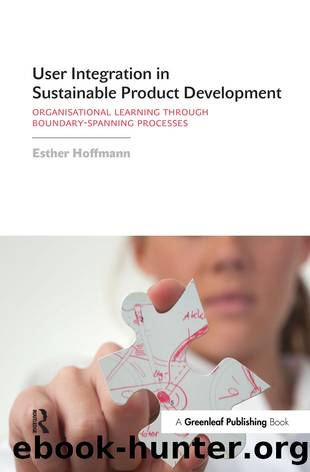User Integration in Sustainable Product Development by Hoffmann Esther;

Author:Hoffmann, Esther;
Language: eng
Format: epub
Publisher: Taylor & Francis Group
Case study research is especially valuable for emerging research areas that are not well understood (Eisenhardt 1989). The contributions case studies make to research are, first, that one can learn from the study of a particular, not yet understood, case and, second, that an in-depth case study can provide an understanding of the relevant aspects of a new or problematic research area (Punch 1998: 156). The combination of sustainable innovations with boundary spanning, organisational learning and user integration is a rather young research field, and this combination is challenging and full of unanswered questions. Moreover, the combination of user integration with organisational learning provides a freshness of perspective (see Eisenhardt 1989) on supportive factors for user integration and allows us to draw practical conclusions.
The analysis of how or why questions is the main task of case studies (Yin 2003). The aim of this thesis is to analyse how companies can learn through consumer integration in product development and what parameters influence the learning process, that is to say why they learn. A case study based on analytical propositions that aim at explaining why companies learn (see the hypotheses in Section 4.6) is suited to answering these questions. The following case study is thus an explanatory (see Yin 2003) or instrumental (see Stake 2000) case study aiming at clarifying the phenomenon of organisational learning through boundary-spanning activities and refining the theoretical background.
Case study analysis can be divided into single-case studies and multiple-case studies (comparative case studies). Here, a single-case study is chosen for several reasons. First, the theoretical framework and the hypotheses formulated may guide the research in such a manner that a single-case study allows me to draw conclusions for theory (critical case in testing a theory); second, examples of companies engaging in sustainability-oriented boundary-spanning processes with consumers are rare and are difficult to access for researchers; hence, developing and testing INNOCOPE is a revelatory case. Moreover, I take a longitudinal approach by studying the company at different points in time (longitudinal case); and, last but not least, gaining access to a case and studying it in detail is a time-consuming and arduous task, and it would not have been possible to manage and assess another application of the INNOCOPE method within the GELENA research project. Planning, facilitating and evaluating the INNOCOPE process placed considerable demands on the time and commitment of the research team, as Gummesson (1991: 180) has described for research in the context of organisational change processes. In addition to a theoretical pre-understanding based on propositions, case studies in companies need a pre-understanding of the corporate environment, corporate processes and the conditions of business, which additionally takes time to acquire (Gummesson 1991: 105). The GELENA team developed INNOCOPE, and the cooperating company was chosen under the condition that it participated in accompanying research. This case study is thus thoroughly accessible for research, which is an essential precondition for cases with a high potential for learning (see Stake 2000).
In planning the case study, this research follows the seminal text on case study research by Robert Yin (2003).
Download
This site does not store any files on its server. We only index and link to content provided by other sites. Please contact the content providers to delete copyright contents if any and email us, we'll remove relevant links or contents immediately.
Hit Refresh by Satya Nadella(8854)
The Compound Effect by Darren Hardy(8508)
Change Your Questions, Change Your Life by Marilee Adams(7371)
Nudge - Improving Decisions about Health, Wealth, and Happiness by Thaler Sunstein(7241)
The Black Swan by Nassim Nicholas Taleb(6762)
Deep Work by Cal Newport(6563)
Daring Greatly by Brene Brown(6222)
Rich Dad Poor Dad by Robert T. Kiyosaki(6174)
Principles: Life and Work by Ray Dalio(5957)
Man-made Catastrophes and Risk Information Concealment by Dmitry Chernov & Didier Sornette(5646)
Playing to Win_ How Strategy Really Works by A.G. Lafley & Roger L. Martin(5493)
Digital Minimalism by Cal Newport;(5389)
Big Magic: Creative Living Beyond Fear by Elizabeth Gilbert(5351)
The Myth of the Strong Leader by Archie Brown(5237)
The Slight Edge by Jeff Olson(5199)
Discipline Equals Freedom by Jocko Willink(5156)
The Motivation Myth by Jeff Haden(5001)
Stone's Rules by Roger Stone(4854)
The Laws of Human Nature by Robert Greene(4770)
